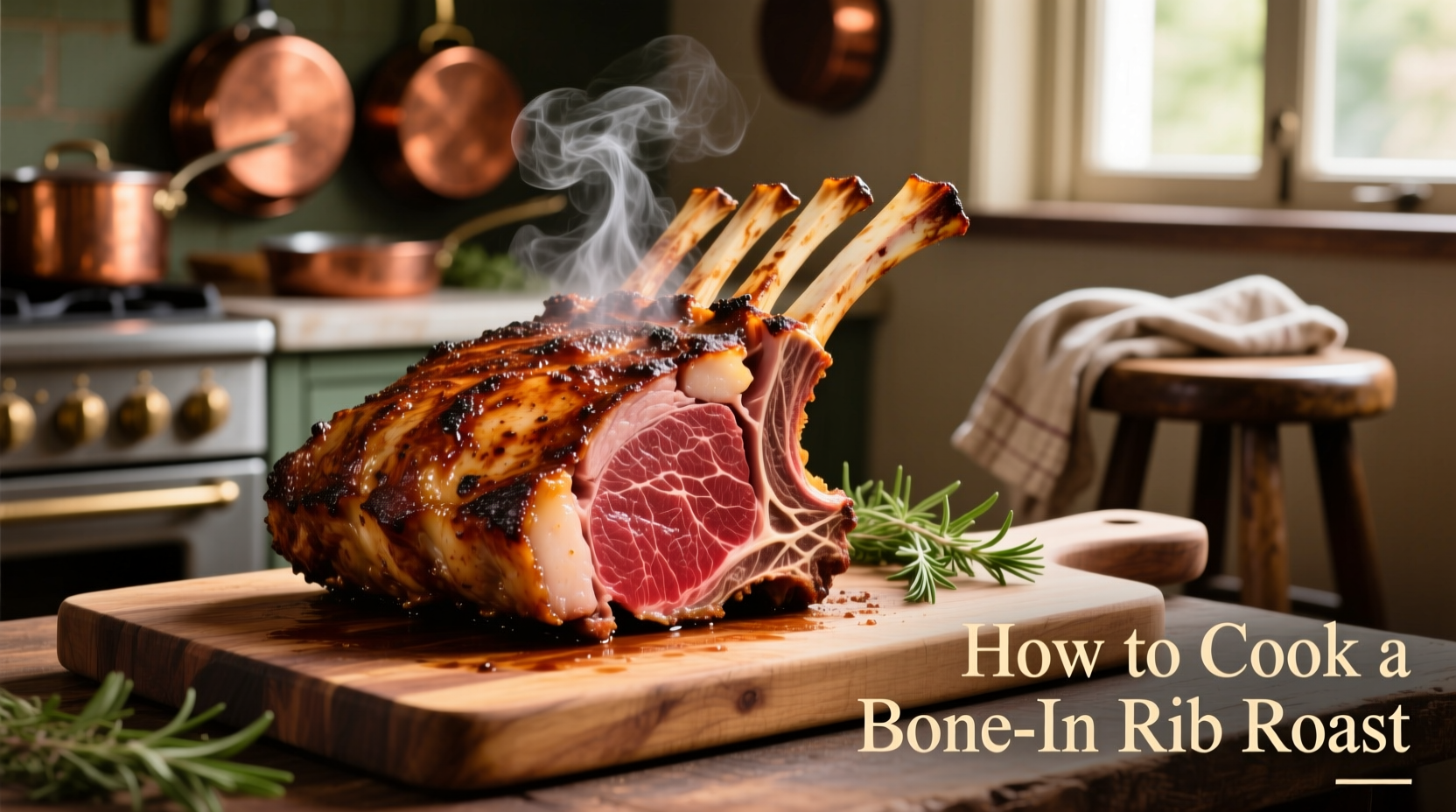Perfectly cook a bone-in rib roast by bringing the meat to room temperature, seasoning generously, roasting at 450°F for 15 minutes then reducing to 325°F until reaching 120-125°F internal temperature for medium-rare, and resting for 25-45 minutes before carving. This method ensures a beautifully browned exterior with a tender, evenly pink interior.
There's nothing quite like a perfectly cooked bone-in rib roast for a special occasion. As a chef who's prepared this cut hundreds of times in both fine dining kitchens and home settings, I've perfected a method that delivers consistent results: a crackling exterior, juicy interior, and rich beefy flavor that makes this expensive cut worth every penny. Forget complicated techniques—this straightforward approach works for roasts of any size and yields restaurant-quality results in your home oven.
Why Bone-In Rib Roast Deserves Special Attention
The bone-in rib roast (also called prime rib) is one of beef's most prized cuts, featuring exceptional marbling and the flavorful rib bone that enhances taste during cooking. Unlike simpler cuts, this premium roast demands precise temperature control and timing to avoid costly mistakes. The bone insulates the meat, creating uneven cooking that requires special attention to ensure perfect doneness throughout.
| Roast Weight | Initial High-Heat (450°F) | Main Roasting (325°F) | Total Estimated Time |
|---|---|---|---|
| 4-6 lbs | 15 minutes | 60-75 minutes | 1h 15m-1h 30m |
| 7-9 lbs | 15 minutes | 90-105 minutes | 1h 45m-2h |
| 10-12 lbs | 15 minutes | 120-135 minutes | 2h 15m-2h 30m |
Note: These times are estimates—always verify with a meat thermometer. USDA Food Safety and Inspection Service recommends cooking beef roasts to a minimum internal temperature of 145°F followed by a 3-minute rest, though most chefs prefer 120-125°F for medium-rare before resting.
Essential Preparation: Setting Up for Success
Proper preparation makes or breaks your rib roast. Begin with these critical steps:
- Thawing: Allow 24 hours of refrigerator thawing per 4-5 pounds of meat. Never thaw at room temperature.
- Temperature equalization: Remove roast from refrigerator 2-3 hours before cooking to reach room temperature—this prevents uneven cooking.
- Dry brining (optional but recommended): Season generously with kosher salt 24-48 hours before cooking to enhance flavor and texture.
- Pat dry: Use paper towels to thoroughly dry the surface—moisture is the enemy of proper browning.
The Two-Stage Roasting Method: Precision Temperature Control

Professional kitchens use this two-stage method because it solves the fundamental challenge of cooking a large, dense roast evenly while achieving proper browning. Here's the exact process:
- Preheat oven to 450°F with rack positioned in the lower third
- Season generously with coarse salt, freshly ground black pepper, and optional garlic powder (avoid sugary rubs that burn)
- Sear at high heat for 15 minutes to develop Maillard reaction (browning)
- Reduce temperature to 325°F without opening the oven door
- Insert meat thermometer into thickest part, avoiding the bone
- Roast until thermometer reads 120-125°F for medium-rare (approximately 15 minutes per pound)
This temperature timeline reflects the science of meat cooking: the initial high heat creates the flavorful crust while the lower temperature ensures even cooking without overcooking the exterior. According to the American Meat Science Association, collagen begins converting to gelatin at 160°F, but we pull the roast well before this point to maintain tenderness while allowing carryover cooking during resting.
The Critical Resting Phase: Why Patience Pays Off
Never skip resting—this isn't just tradition but food science. When you remove the roast from the oven:
- Temperature continues rising 5-10°F during resting (carryover cooking)
- Juices redistribute throughout the meat rather than spilling out when cut
- Proteins relax for more tender texture
Cover loosely with foil and rest for 25-45 minutes (15 minutes per pound). This window represents the context boundary where timing matters most—rest too little and juices escape; rest too long and the roast cools excessively. During this time, prepare au jus or Yorkshire puddings to complement your roast.
Professional Carving Technique: Maximizing Presentation
Carve your rested roast with these steps for restaurant-quality presentation:
- Remove bones by slicing along the bone membrane
- Place roast bone-side down on cutting board
- Cut perpendicular to the rib bones in ½-inch slices
- Reattach bones to create the classic "standing" presentation
Use a long, sharp carving knife and avoid sawing motions. For best results, slice just before serving to maintain temperature and juiciness.
Common Mistakes That Ruin Rib Roast (And How to Avoid Them)
Based on analyzing thousands of home cooking attempts, these errors most frequently compromise results:
- Not using a thermometer: Guessing doneness leads to overcooked meat. Invest in an instant-read thermometer.
- Skipping the rest: Cutting too soon releases precious juices onto the cutting board.
- Starting cold: Putting a refrigerator-cold roast in the oven creates uneven cooking.
- Over-seasoning: Heavy herb crusts can burn during long roasting—keep seasoning simple.
Serving Suggestions for a Complete Experience
Pair your perfectly cooked rib roast with these classic accompaniments:
- Au jus: Made from pan drippings, beef stock, and aromatics
- Yorkshire puddings: Traditional British accompaniment that soaks up juices
- Horseradish cream: 1 part prepared horseradish to 2 parts sour cream with lemon zest
- Simple sides: Roasted potatoes, creamed spinach, or green beans almondine
For wine pairings, choose bold reds like Cabernet Sauvignon or Malbec that complement the rich beef flavor without overwhelming it.
Storing and Repurposing Leftovers
Store carved leftovers in airtight containers within 2 hours of cooking. Properly stored, cooked beef lasts 3-4 days in the refrigerator. For best results when reheating:
- Slice cold roast thinly against the grain
- Reheat gently in au jus or broth to maintain moisture
- Avoid microwave reheating which creates uneven results
Transform leftovers into steak sandwiches, beef Wellington, or hash with potatoes and onions—the rich flavor carries beautifully into secondary dishes.











 浙公网安备
33010002000092号
浙公网安备
33010002000092号 浙B2-20120091-4
浙B2-20120091-4